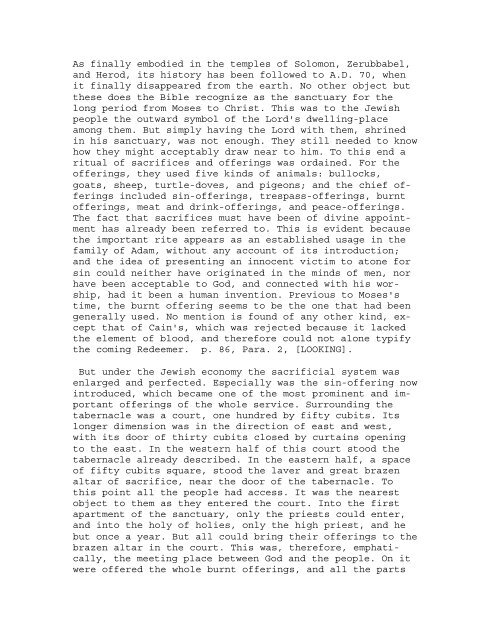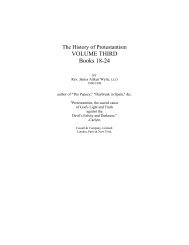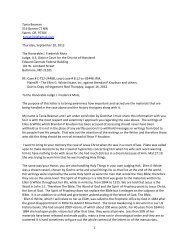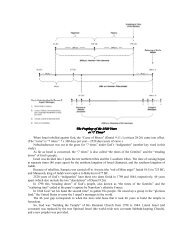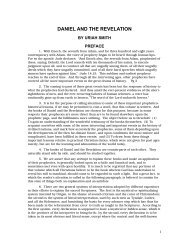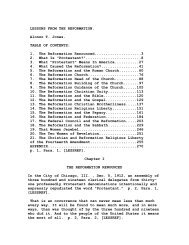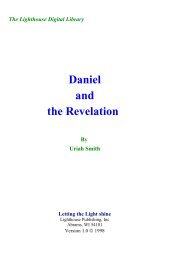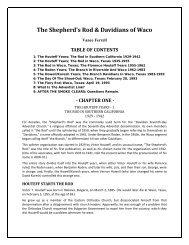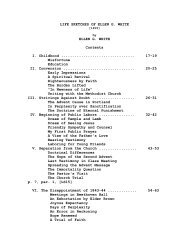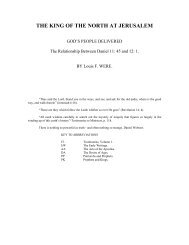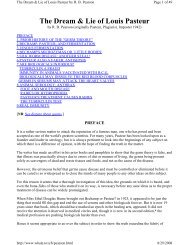LOOKING UNTO JESUS OR CHRIST IN TYPE AND ANTITYPE. BY ...
LOOKING UNTO JESUS OR CHRIST IN TYPE AND ANTITYPE. BY ...
LOOKING UNTO JESUS OR CHRIST IN TYPE AND ANTITYPE. BY ...
You also want an ePaper? Increase the reach of your titles
YUMPU automatically turns print PDFs into web optimized ePapers that Google loves.
As finally embodied in the temples of Solomon, Zerubbabel,<br />
and Herod, its history has been followed to A.D. 70, when<br />
it finally disappeared from the earth. No other object but<br />
these does the Bible recognize as the sanctuary for the<br />
long period from Moses to Christ. This was to the Jewish<br />
people the outward symbol of the Lord's dwelling-place<br />
among them. But simply having the Lord with them, shrined<br />
in his sanctuary, was not enough. They still needed to know<br />
how they might acceptably draw near to him. To this end a<br />
ritual of sacrifices and offerings was ordained. For the<br />
offerings, they used five kinds of animals: bullocks,<br />
goats, sheep, turtle-doves, and pigeons; and the chief offerings<br />
included sin-offerings, trespass-offerings, burnt<br />
offerings, meat and drink-offerings, and peace-offerings.<br />
The fact that sacrifices must have been of divine appointment<br />
has already been referred to. This is evident because<br />
the important rite appears as an established usage in the<br />
family of Adam, without any account of its introduction;<br />
and the idea of presenting an innocent victim to atone for<br />
sin could neither have originated in the minds of men, nor<br />
have been acceptable to God, and connected with his worship,<br />
had it been a human invention. Previous to Moses's<br />
time, the burnt offering seems to be the one that had been<br />
generally used. No mention is found of any other kind, except<br />
that of Cain's, which was rejected because it lacked<br />
the element of blood, and therefore could not alone typify<br />
the coming Redeemer. p. 86, Para. 2, [<strong>LOOK<strong>IN</strong>G</strong>].<br />
But under the Jewish economy the sacrificial system was<br />
enlarged and perfected. Especially was the sin-offering now<br />
introduced, which became one of the most prominent and important<br />
offerings of the whole service. Surrounding the<br />
tabernacle was a court, one hundred by fifty cubits. Its<br />
longer dimension was in the direction of east and west,<br />
with its door of thirty cubits closed by curtains opening<br />
to the east. In the western half of this court stood the<br />
tabernacle already described. In the eastern half, a space<br />
of fifty cubits square, stood the laver and great brazen<br />
altar of sacrifice, near the door of the tabernacle. To<br />
this point all the people had access. It was the nearest<br />
object to them as they entered the court. Into the first<br />
apartment of the sanctuary, only the priests could enter,<br />
and into the holy of holies, only the high priest, and he<br />
but once a year. But all could bring their offerings to the<br />
brazen altar in the court. This was, therefore, emphatically,<br />
the meeting place between God and the people. On it<br />
were offered the whole burnt offerings, and all the parts


